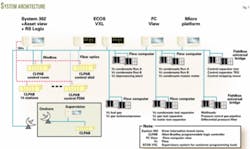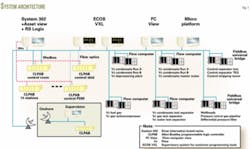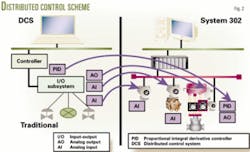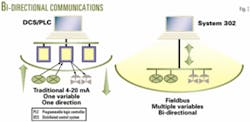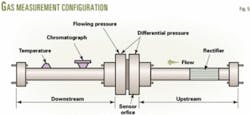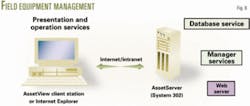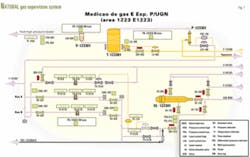To comply with new regulatory requirements, Petróleo Brasileiro SA (Petrobras) modernized the process control on its Merluza offshore platform in the Santos basin, off Brazil.
The fixed platform, installed in 425 ft of water in 1991, produces natural gas with condensate from six wells. The production capacity is 68 MMcfd of gas with 3,300 b/d of condensate. A 200-km pipeline to the Presidente Bernardes refinery transports the production to shore.
To meet the new standards for efficiency, safety, and environmental compliance, Petrobras replaced the outdated pneumatic devices, controlled with interlocking programmable logic controllers (PLCs) activated through field panels. This outdated system required many operators on site, resulting in high production costs.
The new, updated process automation system reduced operational downtime, increased system availability, improved maintenance performance, and increased the reliability of critical production equipment.
Project scope
In June 2000, Agencia Nacional de Petroleo (ANP), Brazil's petroleum authority, established a new standard for fiscal measuring and custody and process transfer applications for Brazil's petroleum industry. The regulations required all oil production units in Brazil to be in compliance by December 2003.
Faced with these requirements, Petrobras undertook the modernization project aimed at improving the management of critical production equipment on the Merluza platform. The project called for the implementation of an asset management solution providing diagnostic data from field equipment.
The system required the availability of real-time information indicating the health and status of remote devices so that Petrobras could implement proactive maintenance service.
In addition to improved monitoring of field equipment, the modernization project helped optimize the processes on the platform to avoid unnecessary and costly downtime.
The project equipped the Merluza platform with a state-of-the-art control room, integrating disparate control functions while at the same time retaining the existing field panels for operational support.
Control system upgrade
Working with its automation partner, Smar International Ltda., Petrobras determined that an open, nonproprietary control system architecture employing Foundation fieldbus would provide the best solution for managing its offshore and onshore production assets. The fieldbus is an all-digital, multidrop, two-way communications system for field equipment, with compatible physical-layer devices and installations (Fig. 1).
The Foundation protocol provides a complete, complementary fieldbus solution that includes a 31.25-kbit/sec low speed (H1) fieldbus for continuous control, and a 100-Mbit/sec high-speed ethernet (HSE) fieldbus for high-performance control applications and plant information integration.
HSE forms the high-speed ethernet backbone for device, subsystem, and enterprise integration. It also supports high-performance control applications using the same open and interoperable function blocks as devices on the H1 network.
Within the fieldbus architecture, the HSE linking device holds the key to integrating H1 fieldbus segments into the HSE backbone. The linking device functions as a bridge between HSE and H1 channels, interconnecting field devices to each other and to other hosts. It is an essential component for integrating system communication with direct input-output (I/O) access and advanced control applications.
From Petrobras' perspective, the fieldbus offered the advantages of a publisher-subscriber model suitable for data exchange by devices when controlling equipment, and a client-server model supervising variables (Fig. 2). This capability meant that at least a portion of the control scheme could be located on the field network itself rather than in higher-level controllers.
Locating control at the field device level restored single-loop integrity, lessening the risk of catastrophic shutdowns.
Foundation technology also enabled bi-directional communications for the collection and transmission of instrument diagnostic information, thus reducing the occurrence of unnecessary downtime and improving safety and regulatory compliance (Fig. 3).
Fieldbus self-diagnostics support proactive device maintenance and allow for advanced asset management solutions.
Also redundant fieldbus systems are tolerant to failures without impairing operations and control.
Foundation fieldbus instruments for primary measurements such as pressure and temperature provide greater accuracy and functionality than conventional technology. Additionally, implementation of the HSE ensured interoperability at higher levels, making it possible to integrate linking devices and gateways.
Process description
An important aspect of the Merluza modernization project was the implementation of a new condensate fiscal measurement skid with natural gas metering runs compliant with API standards.
The condensate skid consists of two measurement runs (A and B) and a master meter run (Fig. 4).
The A and B operational runs serve as a backup for one another, and are in accordance with the API standard. The process uses the master meter run for calibrating meters on the operational runs.
Temperature and pressure transmitters on each skid make flow calculation corrections compliant with API regulations.
A basic sediments and water (bs&w) meter measures condensate water, and a density meter provides calculation corrections. Each skid also contains an automatic condensate sampler and a manual sampler that collect samples for laboratory tests.
As per the AGA Part 3 norm, orifice plates provide the primary measurement of natural gas flow. Flow rectifiers in the system decrease turbulence.
Each straight section of the run has four orifice plates that can be replaced while measurements are on going. A senior orifice fitting device supports these orifice plates and the plates have a maximum flow design of 100, 75, and 25% (Fig. 5).
Flow measurement solution
Petrobras' new control system uses HSE linking devices to integrate field instruments across the Merluza platform, including redundant flow computers supporting Foundation fieldbus.
As per ANP standards, the flow computers execute five fiscal gas-flow measurements (1.5% accuracy) and three fiscal condensate measurements (0.3% accuracy) on the natural gas metering runs and master meter skid.
A test separator also measures gas (2% accuracy) and water appropriation and condensate (1% accuracy).
The fieldbus flow computers and HSE linking devices exchange interlocking and supervision data with the central gateway through an ethernet network with a Modbus TCP/IP protocol. The operation and supervision gateways provide services for supervision, actuation, registration, trend charts, etc.
The fieldbus flow computer is the first instrument of its kind designed for flow calculation, totalizing, and reports in compliance with international standards (including API, AGA, IP, ANSI, ISO, and ANP/INMETRO). The device operates with software that generates reports and functions as the user interface. A tool for field-device management constantly monitors and supervises the system scheduling and calibration.
On the Merluza platform, the fieldbus flow computers enhanced metering operations and pipeline management by expanding access to real-time measurements and instrument diagnostics. The system logs and stores measurements locally in the flow computers according to API standards and then periodically transfers the data to a central collection database using the HMI software application.
Time-stamped logs show alarms and events including configuration changes and faults. The audit trail also includes logged changes made to fieldbus devices. Reports include custody transfer tickets, alarms, events, and the audit trail of changes and meter proving.
With the flow computers, Petrobras operators now have automated tools to monitor pertinent data, identify production problems, detect leaks, and optimize production.
Standard protocols and interfaces simplified the system integration of the flow computers with the instruments and specialized software for production, pipeline integrity monitoring, and product movement.
Field equipment management
The control solution on the Merluza platform includes a field equipment management system that continuously monitors on line the transmitters, positioners, converters, etc., through the fieldbus network.
The tool ensures that users realize all of the benefits stemming from open technologies such as Foundation fieldbus and object linking and embedding for process control (OPC) while reducing operational costs and improving safety across the facility (Fig. 6).
The field equipment management system is a web-based tool that can be remotely accessed from anywhere on the platform. It enables field device diagnostics and maintenance, whether for transmitters or final control elements, through a graphical user interface (GUI). Navigation is via an internet explorer browser and the Windows 2000 operating system. Web pages are developed with ASP technology and made available to clients in HTML format.
In terms of safety, the system architecture permits different levels of access. The device management tool is on a server that authorized staff members can access remotely, thus reducing the high cost of personnel travel to offshore installations. In addition, users may access data on the internet anytime, anywhere.
The field equipment management system maintains a record of operations ranging from maintenance and calibration, to software parameterization, substitutions and operational statistics.
The system database stores relevant information based on a statistical analysis of historic data, prevention, scheduling, and proactive maintenance. On-line monitoring of the plant topology helps identify those devices needing service, and enables significant reductions in maintenance costs when compared with older reactive, preventive and predictive maintenance strategies.
Supervisory system
To meet Petrobras' own strict standards for offshore production units, the Merluza supervisory system employs an OpenVMS (open virtual memory system) operating system running standard supervisory software. The system incorporates a microcomputer with a RISC (reduced instruction set computer) processor, ensuring greater reliability than a conventional microcomputer.
A PLC functioning as a central gateway reads all required variables on the flow computers and linking devices through a TCP/IP (transmission control protocol/internet protocol) Modbus channel. A proprietary network links 15 PLCs, including a controlling PLC for the condensate skid, to the gateway.
The supervisory system provides parallel information on two redundant server stations with dual hard disks. Each station acquires, actuates, registers, reports, and stores information related to platform gas and condensate flow measurements. Passwords provide reliable access control and tracking.
Benefits
Petrobras realized significant operational improvements and business benefits from the controls modernization project on the Merluza platform, including:
- Improved compliance with regulatory standards governing fiscal measuring and custody-process transfer applications.
- Precise calibration of fiscal gas flow and condensate measurements.
- Modern architecture replacing an outdated control platform and integrating regulatory controls with sequential logic in PLCs.
- Single-loop integrity resulting from distribution of control functionality into field instruments.
- Integrated operation unifying process units with different generations of controls.
- Reduced process variability due to improved measurement and control accuracy.
- Multivendor device interoperability enabled through an open, nonproprietary fieldbus protocol.
- Simplified system design, ensuring uniform and consistent networks.
- Reduced commissioning time compared to traditional analog technology.
- Protection of assets without loss of functionality or valuable intellectual property.
- Ease of expansion and maintenance because of simplified system documentation.
- Fewer spare parts requirements than aging PLC and pneumatic systems.
The implementation of a modern, Foundation fieldbus-based control system on the Merluza platform proved to be the best solution for reducing production downtime, enabling interoperability of field instruments, and integrating control and supervisory systems across the enterprise.
The fieldbus technology reduced the cost of commissioning and start-up on the project because cable installation did not impair on-going unit operations during most of the offshore hook-up stage. It also enhanced process performance through increased system availability, greater platform stability, and improved data consistency.
Most important was that the new control architecture enabled compliance with ANP standards while offering expanded functionality. The fieldbus also has gained acceptance at other Petrobras production units, both onshore and offshore.
The authors
Carlos Henrique W. Moura ([e-mail address])is a technical consultant for Petrobras' production and exploration department. He has worked on numerous automation projects for onshore and offshore oil and gas production facilities. Moura has an electronic engineer degree from Federal University of Rio de Janeiro.
Nerivaldo Marangão Martins is a senior instrumentation and maintenance technician for Petrobras. He has more than 20 years of experience researching new technologies and applications for pipeline protection and process automation systems.
Fabrício Pascon ([email protected]) is oil and gas business and systems manager for Smar Equipamentos Industriais Ltda. Pascon has an electrical engineering degree from Paulista State University-UNESP/Brazil.
